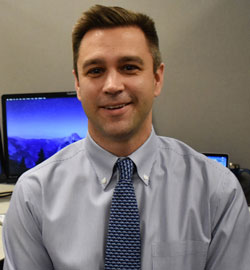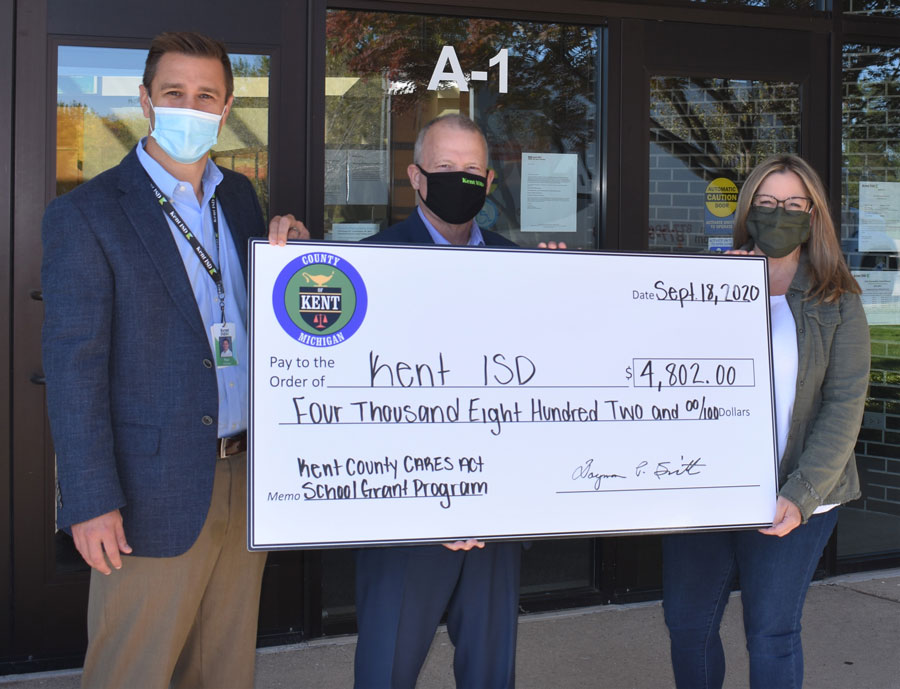In mid-September, Mandy Bolter, chairperson of the Kent County Board of Commissioners, had the enjoyable task of presenting oversized checks at school districts around Kent County. And though the checks were ceremonial, the dollars that they represent are a lifesaver to the 20 school districts in Kent ISD as they struggle with unexpected COVID-19 costs.
In a statement, Ron Caniff, the Kent ISD superintendent said simply: “We appreciate the support of the Kent County Board of Commissioners. This will help schools secure the needed resources and services to meet the needs of students during this pandemic.”
All told, Kent County schools – public, charter and private – received $2 million to offset those costs after a late-August vote of approval by the board. That money in turn is part of $115 million that the county received as part of the Coronavirus Aid, Relief and Economic Security (CARES) Act, the $2.2 trillion bill signed into law in late March.
‘This will help schools secure the needed resources and services to meet the needs of students during this pandemic.’
— Ron Caniff, Kent ISD superintendent
The $2 million given to Kent County schools — around $16 per student — comes with parameters. The money is restricted to COVID-19 expenses, including such things as personal protection equipment, cleaning supplies, online learning technology expenses, ventilation upgrades and even people costs such as hiring more nurses.
Local districts are also receiving other state and federal funds aimed at helping them meet COVID-related expenses estimated at $400 to $500 per student.
Public schools in Kent County planned to spend their money in a variety of ways with PPE, technology and staffing being the three most-popular responses to a survey sent by Kent ISD to county superintendents.

Money Being Used for PPE, Full-time Nurse and More
For Kent ISD, the $4,802 it received from Kent County will go toward its Special Education Center Programs – nine different programs at 17 sites throughout the county, with more than 300 staff serving more than 1,000 children, students and young adults.
Director Paul Dymowski said the funds from the county already are being used well.
“Students in our programs have complex needs and require personal care,” Dymowski said, “and we have purchased additional PPE to provide protection to staff and students. We are committed to providing the protection, and this money demonstrates the community’s commitment to protecting our students and staff. We are grateful for the collaborative effort.”
At Godfrey-Lee Public Schools, superintendent Kevin Polston was thrilled to use the district’s $29,400 for the district’s school nurse, Rachel Collins, to be full time. She is also partially funded by Spectrum Health’s Healthier Communities program.

“We were only at three days a week,” he said, “but with the health care needs of students, families and staff associated with COVID-19, we believed it was important to have a full-time nurse. Without question, our schools are safer by having a full-time nurse.”
Polston added that Collins already has performed training for all staff; identified necessary protocols, procedures and PPE to respond to symptomatic students or staff; and assisted families with navigating the health care system for general health care and COVID-specific situations.
“A full-time health professional in our district, provides expertise and peace of mind for our students, staff and families that Godfrey-Lee is making face-to-face learning as safe as possible.”
At Cedar Springs Public Schools, where $58,158 came in via Kent County, Superintendent Scott Smith was also grateful for the collaboration.
“Like every district, Cedar Springs has a wide range of new expenses related to providing students and families a safe educational experience,” Smith said. “These funds will prove extremely beneficial as we provide the best education possible for Cedar Springs students.”
Cedar Springs will be using the funds for PPE, technology and professional development related to remote learning.

One of Four Counties to Get Direct Funding
Stan Stek, vice-chair of the Kent County Board of Commissioners, noted that
counties with more than 500,000 residents qualified for direct distribution from the federal government to the county, with the county being given the flexibility to determine how to best apply these funds within the county.
In Michigan, Kent County was one of just four counties that received direct funding from the federal government. It is distributing its allocation in numerous ways, including: about $25 million for small business recovery grants administered by the Grand Rapids Chamber; $15 million for local units of government; $9.5 million for programs of local nonprofits administered through the United Way and much more.
Stek said the $2 million to schools was an important allocation.
“Providing all schools in Kent County support to get them back up and educating our children was widely seen as one of our critical needs,” he said. “So even though we know schools have access to other funding responses to COVID-19, we felt it was critical that the county provide additional support to all of our educational organizations.”
Stek added that the Allocation Committee of the Board of Commissioner has not ruled out some additional funding for Kent County schools before the end of the year.









